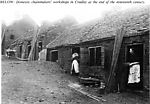 Domestic Chain-shops in Cradley
Domestic Chain-shops in Cradley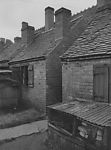 Domestic Chain-Shop
Domestic Chain-Shop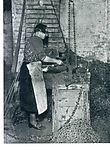 'Ommerin Amidst the Grime
'Ommerin Amidst the Grime Image from Period Postcard
Image from Period Postcard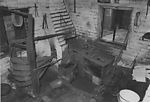 Interior of Domestic Chain-Shop
Interior of Domestic Chain-Shop Chain-shop Interior
Chain-shop Interior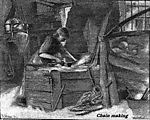 Chain-making by Tom Hill
Chain-making by Tom Hill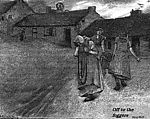 Off to the foggers by Tom Hill
Off to the foggers by Tom Hill

The domestic chain industry was a vital part of the industry and made it possible for women to add to the family income, while at home looking after the children.
A domestic workshop was a private house with a workshop behind. No machines were used and it consisted of a hearth, bellows for blast (air) and tools. The work was the same as in the factories except that only small chain, mainly for agricultural and domestic use, was made.
The factory owners would not employ enough people to make all the chain sold, so middlemen would act as agents for the larger manufacturers. These middlemen would then place the work with the domestic workshops, providing the homeworkers with the iron rod, the homeworkers supplying their own breeze (coke) and blast.
The wrought iron rods were weighed prior to delivery or collection by the homeworker or middleman. The finished chain was weighed in, and this was how the chainmaker was paid.
A skilled and experienced woman could make about 280lbs (127kgs) of 3/8in (10mm) chain per week. This was the largest size of chain women were allowed to make, the larger and higher quality chain was made by men.
Some of the middlemen were dishonest, and were known as “foggers”. They could cheat the chainmaker by lying about the weight. Sometimes outworkers were paid in the form of “truck”, which was token money that could only be spent in a “Tommy Shop”, a shop owned by the fogger selling goods at high prices. Three Acts of Parliament stopped this by the start of the 20th century. The foggers lived off the backs of the chainmakers, and were hated.
All members of the family may have worked in this domestic industry, from the grandparents to the youngest grandchildren. There were more women, girls and young boys than men, as they could get better paid work in the factories. Also, the women working from home were able to look after the children. They often worked into the evening. Eventually a by-law was passed stopping their work at 9pm, due to the complaints from neighbours about the continuous hammering.
Rollover the captions in the box to see the available images in thumbnail format, click the caption to see the full-size image
| Reference: | 659 |
| Keywords: | |
| Archive Ref: | K.G. Lib 1994/013/1250 |
| Updated: | Thu 7 Jun 2007 - 10 |
| Interpretation written by | Louis Howe |
| Author's organisation | Curatorial |
| Organisation's website |